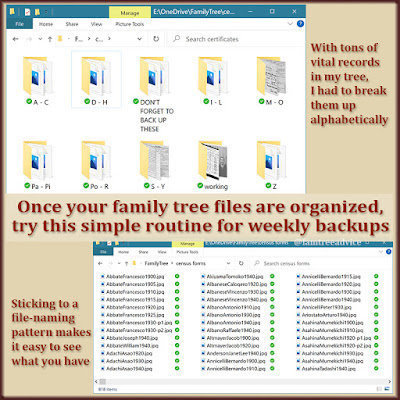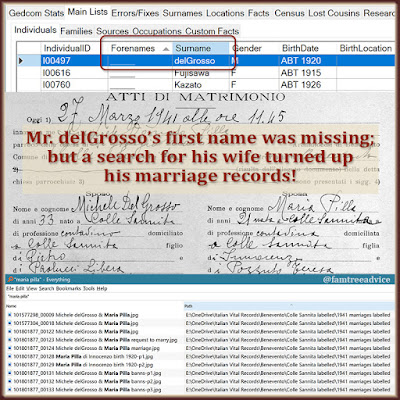When you've been swimming in old Italian vital records for as long as I have, you learn a lot of little tidbits. Using those tidbits, I broke through a brick wall last week.
I finally got past one of my 5th great grandfathers. Once I found exactly the right record, I shot straight up his paternal line to my 8th great grandparents!
It was one heck of a process, and I'm so glad I stuck with it.
Since you may not know all the tidbits I've learned along the way, I thought it'd be helpful for me to list them for you. These facts are true of Italian vital records and some church records. Some of these facts should apply to other countries' vital records as well.
- Italian women keep their father's last name for life. There is no "maiden name" and "married name." There's one name. If they boarded a ship to emigrate, they used their one-and-only last name.
- Birth records may include the name of the baby's grandfathers and if they're alive or dead. If it says di and a name, the grandfather is alive. If it says fu and a name, the grandfather is dead.
- Death records name the deceased's parents and spouse, and whether they are alive or dead. But, if a person died in another town, the people there may not know the names all the deceased's parents and spouse. And if a man died quite early, his death record may say that he is married, but not give his wife's name.
- An Italian marriage requires the consent of the bride and groom's parents. If a parent is dead, a grandfather may consent. If everyone's dead, there needs to be proof. So, the marriage records can include:
- Bride and groom's birth or baptism record, possibly with their parents' ages at the time. Note: The earlier in someone's life their age is stated, the more reliable it is.
- Bride and groom's mother's death record, if she's dead at the time of the marriage
- Bride and groom's father's death record, if he's dead at the time of the marriage
- Bride and groom's grandfather's death record, if parent and grandfather are both dead
- Bride and groom's previous spouse's death record. Note: There was no divorce in Italy until 1970, but widows usually remarried quickly.
Last week I noticed that my Grandma Lucy's line had a dead end at my 5th great grandfather, Antonio Zeolla. I've done tons of work to make every vital record from Antonio's town searchable. So why didn't I know when he died or who his parents were?
 |
| Building out all of Antonio's children and grandchildren was the key to finding his ancestors. |
I did know Antonio was still alive in 1817. I learned that from his wife's death record.
- If the deceased's spouse is dead, the document says they were the vedovo di or vedova di, followed by their late spouse's name. Vedovo/a di means widow of.
- If the deceased's spouse is alive, the document says they were the marito di or moglie di, followed by their spouse's name. Marito di means husband of. Moglie di means wife of.
I searched for an Antonio Zeolla who was the widow of Andreana Piacquadio (my 5th great grandmother). There was no widow of Andreana. Had Antonio remarried? In 1817 when Andreana died, the couple had 2 very young children. Antonio should have remarried.
But I couldn't search for the marriage of an Antonio Zeolla. That's a common name in the town of Colle Sannita, and I wouldn't know if I'd found the right man. If he remarried at the right time, the documents would include Andreana's death record. I searched for that. But he didn't remarry at the right time.
I knew what I had to do.
I had to find all of Antonio and Andreana's children and their marriage records. But Antonio was still alive when his children married.
Antonio's grandchildren's marriage records would include his death if they married:
- after their parent had died, and
- after Antonio had died.
I began identifying his grandchildren and searching for their marriages.
At last I found what I needed. In 1850, Andreana Zeolla got married. She was the daughter of Antonio's eldest son. Luckily for me, When she married, both her father and grandfather were dead. After hours of searching, I found Antonio's death record from 1848. I learned his parents (my 6th great grandparents) were Marco Zeolla and Donata Tedesco.
 |
| It took his granddaughter's marriage to positively identify Antonio's death date and second wife. Then I found even more. |
The 1848 death record says Antonio was the widow of a different woman. It's clear from the context that this is the Antonio I was looking for. His second wife is the reason I couldn't find him.
Now I knew he had remarried Lucia Piacquadio, so I found his 1819 marriage documents. Those documents held an even bigger treasure for me.
When Antonio remarried, both his father and grandfather were dead. Hurray, right? I learned that:
- my 6th great grandfather Marco Zeolla died in 1791
- he was the son of Antonio Zeolla and Angela Iacobaccio, my 7th great grandparents
- my 7th great grandfather Antonio Zeolla died in 1764
- he was the son of Marco Zeolla and Fioribella diRuccia, my 8th great grandparents!!
While this method doesn't always lead to this much success, you mustn't overlook it. When you can't find the document you need, work around it. A family member—one you haven't found yet—may be the key to help you break down that brick wall.











